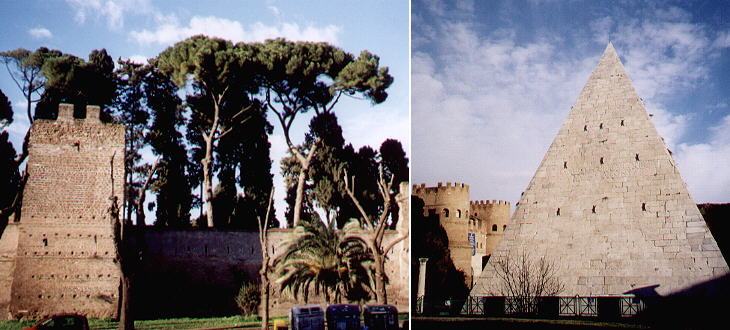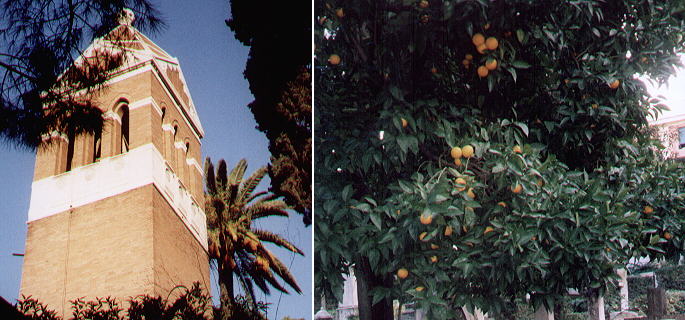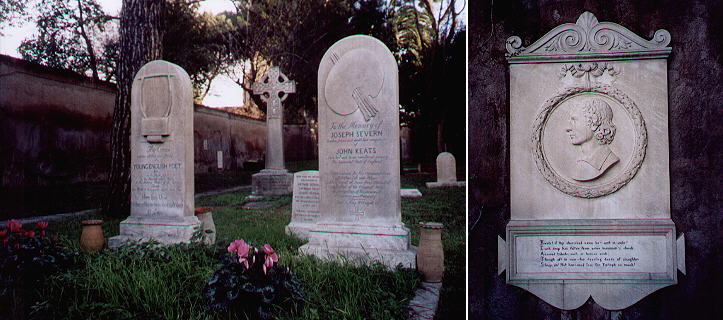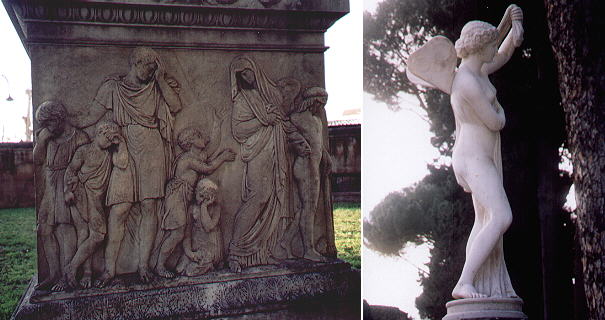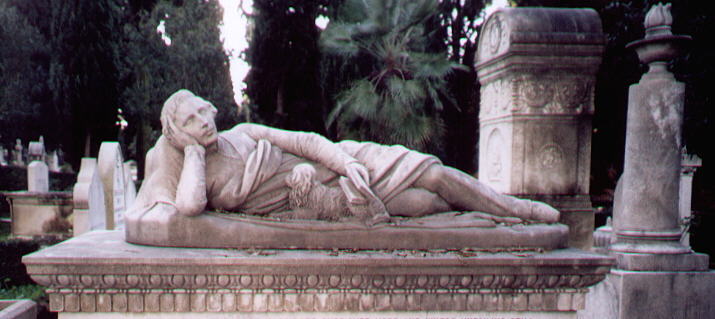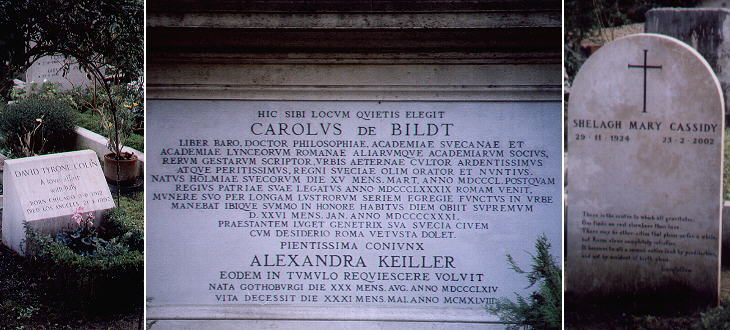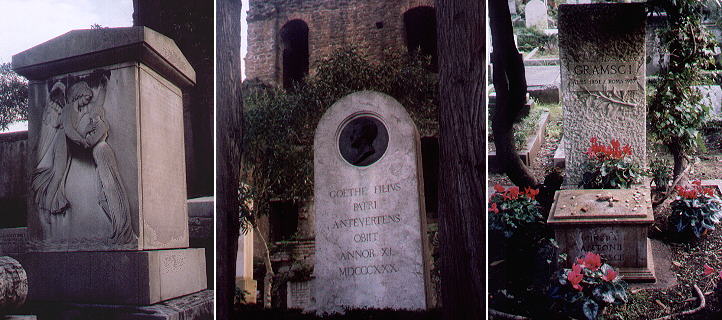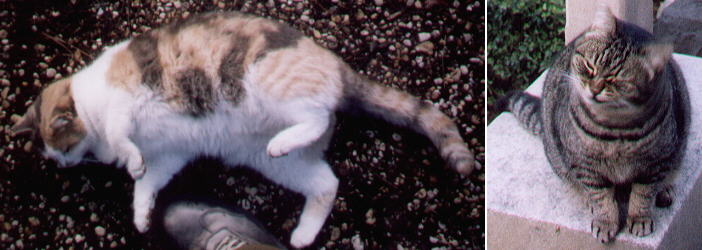  (how to spend a peaceful day in Rome) 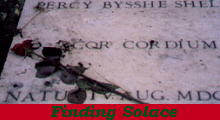 at the Protestant Cemetery at the Protestant Cemeterya rose on the tomb of Percy Bysshe Shelley - Cor Cordium (heart of hearts) In 1648 the Peace of Westphalia brought to a close the Wars of Religion which had followed
the posting by Martin Luther of his theses on the church door at Wittenberg in 1517. The treaty clauses were far from
establishing religious freedom, but nevertheless they led to some acceptance of the different religious professions.
In the last years of the XVIIIth century what was meant by the local authorities to be a sort of second (or third) rate burial ground became very popular among the foreigners visiting Rome: the Pyramid, the ancient walls, the simplicity of the site all appealed to the educated traveller who had knowledge of Gray's Elegy written in a country churchyard and of Macpherson's Poems of Ossian. In February 1788, in the last days of his Italian journey, J. W. Goethe wrote: Should I be laid to rest beside the Pyramid of Cestius, these two poems ("Hans Sachs" and "Mieding's Death") will serve as my dying confession and my funeral oration. Given that at the time Goethe was in good health and in high spirits the sentence shows how much he liked the site of the burial ground.
Cypresses and pines cast their dark shadows on the tombs, but palms and orange trees add a milder Mediterranean touch.
In the early XIXth century the cemetery was enlarged and a new wall completed the protection given by the ancient ones. The oldest part of the cemetery is close to the Pyramid and here John Keats lies in an unnamed monument: Here lies One Whose Name was writ in Water is the epitaph he dictated to his friend Joseph Severn, a painter who wanted to be buried next to him. A relief portraying Keats is accompanied by verses, the acronym of which reads K-E-A-T-S. K-eats! if thy cherished name be "writ in water" E-ach drop has fallen from some mourner's cheek; A-sacred tribute; such as heroes seek, T-hough oft in vain - for dazzling deeds of slaughter S-leep on! Not honoured less for Epitaph so meek!
Although most graves are very simple, a few are rather monumental and especially those of the early
XIXth century have fine Neoclassic reliefs: the image above shows on the left a relief portraying the Angel of Death bringing away a woman (Elisa, wife of George Watson, a lady from Massachusetts, or to be consistent with the Latin epitaph "Massachusettensis") mourned by her husband and children: all dressed as ancient Romans;
the sculpture on the right portrays Psyche.
John Keats was not the only foreigner who came to Rome hoping the Italian sun would restore his health. The young man (shown above) portrayed with his beloved dog and wrapped in a blanket "was beloved by all who knew him, and most precious to his parents and family, who had sought his health in many foreign climes. He departed this life in Rome, aged 21 years".
Many epitaphs are a tribute to Rome: in some cases the dead were buried in this cemetery because of their firm will and their epitaphs show their love for the city: David Tyrone Colin (left) died in Los Angeles but wanted to be buried here as he had "A love affair with Italy"; Charles de Bildt (middle), a Swedish Academist, came to Rome in 1889 and lived here until his death in 1931: his daughter, Blanciflor, married a Boncompagni Ludovisi and at her death she donated one of the family palaces to the City of Rome; Shelagh Mary Cassidy (right), chose to dedicate to Rome her epitaph by citing Longfellow: There is the centre to which all gravitates One finds no rest elsewhere than here. There may be other cities that please us for a while, but Rome alone completely satisfies. It becomes to all a second native land by predilection, and not by accident of birth alone.
"I may seem unduly to refine, but the injunction to the reader in the monument to Miss Bathurst, drowned in the Tiber in 1824, "If thou art young and lovely, build not thereon, for she who lies beneath thy feet in death was the loveliest flower ever cropt in its bloom", affects us irresistibly as a case for tears on the spot. The whole elaborate inscription indeed says something over and beyond all it does say. The English have the reputation of being the most reticent people in the world, and as there is no smoke without fire I suppose they have done something to deserve it; yet who can say that one does n't constantly meet the most startling examples of the insular faculty to "gush"? In this instance the mother of the deceased takes the public into her confidence with surprising frankness and omits no detail, seizing the opportunity to mention by the way that she had already lost her husband by a most mysterious visitation. The appeal to one's attention and the confidence in it are withal most moving. The whole record has an old-fashioned gentility that makes its frankness tragic. You seem to hear the garrulity of passionate grief." (Henry James - Italian Hours) The whole inscription reads as follows THE REMAINS OF ROSA BATHURST WHO WAS ACCIDENTLY DROWNED IN THE TIBER ON THE 11 OF MARCH 1824. WHILST ON A RIDING PARTY; OWING TO THE SWOLLEN STATE OF THE RIVER, AND HER SPIRITED HORSE TAKING FRIGHT. SHE WAS THE DAUGHTER OF BENJAMIN BATHURST WHOSE DISAPPEARANCE WHEN ON A SPECIAL MISSION TO VIENNA, SOME YEARS SINCE, WAS AS TRAGICAL AS UNACCOUNTABLE: NO POSITIVE ACCOUNT OF HIS DEATH EVER HAVING BEEN RECEIVED BY HIS DISTRACTED WIFE. HE WAS LOST AT TWENTY SIX YEARS OF AGE. HIS DAUGHTER WHO INHERITED HER FATHER'S PERFECTIONS, BOTH PERSONAL AND MENTAL, HAD COMPLETED HER SIXTEENTH YEAR WHEN SHE PERISHED BY AS DISASTROUS A FATE. READER WHOEVER THOU ART, WHO MAY PAUSE TO PERUSE THIS TALE OF SORROWS, LET THIS AWFUL LESSON OF THE INSTABILITY OF HUMAN HAPPINESS SINK DEEP IN THY MIND.- IF THOU ART YOUNG AND LOVELY BUILD NOT THEREON, FOR SHE WHO SLEEPS IN DEATH UNDER THY FEET, WAS THE LOVELIEST FLOWER, EVER CROPT IN ITS BLOOM.- SHE WAS EVERY THING THAT THE FONDEST. HEART COULD DESIRE, OR THE EYE COVET, THE JOY AND HOPE OF HER WIDOWED MOTHER WHO ERECTS THIS POOR MEMORIAL OF HER IRREPARABLE LOSS. "EARLY, BRIGHT, TRANSIENT, CHASTE, AS MORNING DEW" "SHE SPARKLED, WAS EXHALED AND WENT TO HEAVEN". When Goethe imagined being buried beside the Pyramid, he did not know he had a foreknowledge that his son, born in 1789, would die in Rome in 1830 and be buried beside the Pyramid. The monument to Julius August Goethe shows how hard it is to be the son of a genius. The epitaph does not mention his first name: he is just "Goethe filius" (Goethe's son). The cemetery is usually called Cimitero degli Inglesi, but its proper name is Cimitero Acattolico (non-Catholic), because in addition to Protestants it serves as burial ground for Greek Orthodox, Jews, Zoroastrians and atheists. The image on the right (above) shows the monument to Antonio Gramsci, one of the founders of the Italian Communist Party, deceased in 1937, after having spent many years in prison.
Other Days of Peace pages: At the Flea Market At the Beach Christmas in Rome Eating Outdoors A visit to Roseto di Roma A Sunny Day in Villa Borghese Voicing Your Views and feeling better! Celebrating the Foundation of Rome The procession of La Madonna de Noantri
Go to my Home
Page on Baroque Rome or to my Home Page on Rome
in the footsteps of an XVIIIth century traveller.
|
All images © 1999 - 2005 by Roberto Piperno. Write to romapip@quipo.it (alternative e-mail address at romeartlover@katamail.com)
